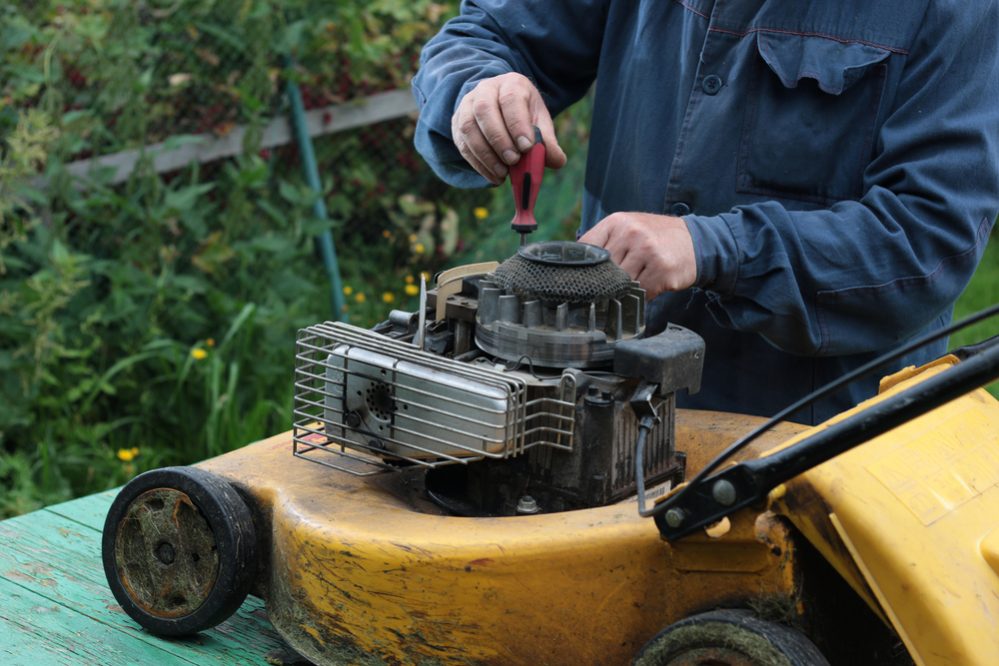Some people enjoy mowing the lawn and many don’t. One thing’s for sure, though – if you have to fight with your Lawn mower to even make it work properly, a boring but simple chore can quickly turn into something far more frustrating that will have you pulling your hair out and kicking the machine in exasperation.
If your Lawn mower starts then stops after a few minutes, there could be several reasons. Here, we’ll look at what could be causing the problem and give you some suggestions for how to fix it.
Be systematic

If your Lawn mower is playing up, the key to fixing it is being systematic. To be able to repair a problem, first, you need to locate and identify the problem. To do this, you need to work through all the possibilities one by one to eliminate them until you find the cause of the issue.
Once you identify the problem in this way, you can then begin to think about what to do to rectify it.
Here, we’ll work through the different possibilities, starting with the most basic and common before moving onto the more complicated issues that can arise. In this way, you can eliminate each one until you discover what’s wrong with your machine.
Here’s a video that shows you how it’s done.
Lawn Mower Possible problems
Here are the different areas you should check.
· Are you out of gas?
Since we said we’re going to begin with the most basic issues and work from there, we’ll start with this. Sometimes, people see their mower stop working and automatically assume the worst – but you could just be out of gas.
Check to see that your Lawn mower has not run out of fuel. If it has, you’ve already found your answer.
· Is there another problem with the power supply?

The same is true if you are not using a gas-powered mower. Is the battery out of charge? Or if it is a corded model, has it come unplugged? Is there a power cut? You need to eliminate these kinds of possibilities before you move onto more technical areas.
If you have a self-propelled Lawn mower, an electric cordless Lawn mower or anything else that doesn’t run on gas, don’t forget to check the power supply before you look at anything else!
· Are the fuel lines clean?
One problem can be that when you run out of fuel, if there is any debris in the tank, this will be sucked into the fuel lines and stop it from restarting. If your mower doesn’t restart after running out of fuel, make sure the fuel lines are clear and try again.
· Is it a problem with a spark plug?
The next thing to check is the spark plug. Is it clean? Is it old? Is it properly attached?
If it is not properly fixed in place, simply make sure it is attached correctly and try again. If it is dirty, this will also prevent it from working correctly so give it a quick clean.
If your spark plugs are old, they may also begin to fail – in this case, you should replace them. In fact, changing your spark plugs is not expensive and should be part of your annual early spring maintenance schedule before the growing and mowing season gets underway.
· Is the air filter blocked?
Another reason a mower might start and then stop is that the air filter becomes blocked. If this is the problem, then it’s good news because it’s easy to fix since most mower filters are cleanable.
Check to see if the filter is blocked and clean as necessary – then try again to see if this has solved the problem.
· Is the mower blocked by grass clippings or long grass?

These are two related problems. First, if grass clippings clog the blades, this may cause the engine to stop after running for a while. After checking the problems mentioned above, the next thing to look at is whether the blades are clogged with grass.
If you see that a build-up of clippings is preventing the blades from turning properly, this is another easy problem to fix. Simply clean underneath the mower and remove all lumps of grass and try again.
Sometimes mowers can also stop because the grass you are trying to cut is too long. If your mower stopped as you attempted to cut a longer patch of grass, this could well be what was to blame for the mower breaking down.
Again, check that no grass is clogging up the blades and then adjust the cutting height to a higher setting. You may find that this resolves the problem.
· Dull, damaged or loose blades

If your blades are not sharp, are damaged or are not properly attached, this may also cause the engine to stop, especially when cutting thicker grass.
Making sure the blades are in good condition and are properly attached should also be a part of your annual mower tune-up in the spring. Even if they don’t cause the engine to stop, dull blades tear grass rather than cutting and can damage your lawn.
· Low oil level
Another quick fix is to check the oil level. If you are running a Lawn mower that is low on oil, this could cause it to cut out after running for a while. If you check the oil and find it is low, simply ensure it is topped up properly and you’ll be good to go.
· Compression problems
If you have checked everything above and still can’t discover the problem, you may have a compression problem. This may be because as the mower heats up, the valve changes shape slightly, making the engine less efficient.
This kind of problem is more difficult to diagnose, and unless you are comfortable tinkering with engines, you might be better off having a professional have a look at your mower for you.
With specialist equipment that you probably won’t have available at home, a professional can identify the problem – and can then resolve the problem. The fix will usually involve realigning the valve lash, something that not everyone is capable of doing by themselves.
Be systematic – work from obvious and simple to more complicated
The key to identifying the problem is being systematic. Start with the most obvious answers – like running out of fuel – and work from there. By eliminating each possible issue one by one, you will eventually be able to find the problem. Once you identify why your mower stopped you can start to think about how to rectify the problem.

Leave a comment